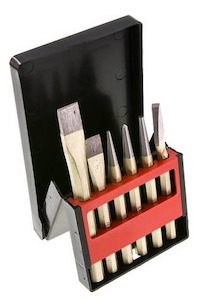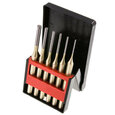Cold Chisels

Figure 1: A cold chisel set applicable for metalwork and masonry.
A cold chisel tool has a sharp edge for cutting and shearing hard materials such as metal and masonry. The descriptor cold means that metal is not preheated before using the tool. A cold chisel is ideal for cutting through thick metal stock when a hacksaw is unsuitable. This article discusses the types of cold chisels and their use for various applications. Read our chisel overview article for more details on teh various chisel types.
Table of contents
View our online selection of cold chisels and air hammers!
Cold chisel designs and applications
Cold chisels are typically tempered carbon tool steel, making them hard enough to get through metal and masonry. Most cold chisels do not have a handle like wood chisels but end with a hard metal shaft. Cold chiselers, like blacksmiths, use hammers to hit the chisel and drive it into the hard material.
As with wood chisels, there are many different types of cold chisels. Four of the most common cold chisels are the flat chisel, cape chisel, round-nose chisel, and diamond point chisel. It is important to remember that different chisel types are suitable for different jobs.
Flat chisel
Two cold chisel designs typically get the name flat chisel. The first design is a cold chisel flat on one side with an angled edge on the other. The second design is wedge-shaped with 60° angles on both sides. The edge is typically 89 mm (3.5 in) wide. In metalworking, flat chisels are suitable for cutting material off bars and sheet metal, splitting nuts, and shearing off rivets. In masonry, flat chisels detail and finish the material or smooth surfaces.
Cape chisel
A cape chisel has a large wedge-shaped head that supports its slight, narrow cutting edge. The edge is typically 12.7 mm (0.5 in) or narrower. Cape chisels can cut narrow slots into metal and stone. Also, cape chisels are ideal for locking nuts and bolts. After the machinist tightens the nut, they use a cape chisel to deform the threading on the bolt so the nut cannot loosen.
Round-nose chisel
A round-nose chisel has a semicircular-shaped edge and a wedge-shaped body. Similar to cape chisels, the edge is typically 12.7 mm (0.5 in) or narrower. In metalworking, a round-nose chisel cuts round grooves like oil ways in bearings.
Diamond point chisel
A diamond point chisel has a four-sided tapered cutting edge. The width of the cutting edge varies from 6 to 16 mm. Non-sparking diamond chisels are suitable for metalworking in the petrochemical and grain industries. In metalworking and masonry, diamond point chisels are great for clearing material from edges, squaring holes, and cutting V-corners.
How to cold chisel
Cold chiseling is as straightforward as wood chiseling; it's as simple as hitting a chisel with a hammer. However, there are some specifics of the work to understand:
- PPE : Wear gloves, safety glasses, and thick clothing. Metal shavings and pieces can fly off the work material.
- Sharpening: Use a bench grinder with fine grit. When sharpening, move the chisel's bevel and edge across the grinder. Periodically remove the chisel from the grinder to prevent too much heat buildup.
- Hammer: Two types of hammers are suitable for cold chiseling: ball peen and club hammers. Ball peen hammers are heavy enough, and club mallets have a wider surface head for jobs that need extra power at the loss of some accuracy. The head of the hammer should be at least two times wider than the chisel.
- Lubricate: Lubricate the head of the chisel with a few drops of machine oil. This will reduce friction and excessive heat buildup.
- Hammering: Hold the chisel at approximately 45° when shaving pieces off the metal. Hold at 90° when punching holes through the material.
FAQs
What is cold chiseling?
Cold chiseling uses chisels to shape or remove material from hard materials such as metal and masonry. Cold chiseling means that the material is not hot during the chiseling process.
What is the difference between a cold chisel and a wood chisel?
A cold chisel is typically tougher than a wood chisel and doesn't often have a handle. Also, cold chisels need to be hammered. A wood chisel may or may not need to be hammered.





